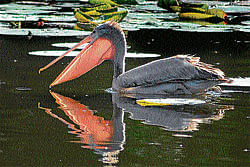
The city, which was once dotted with a number of natural tanks surrounded by the green fields, is slowly losing its identity to pave way for the formation of new layouts. The birds, that were getting food and shelter in the natural environs, are slowly moving out of the city.
Hitherto, birds were nesting on trees near Kukkarahalli, Lingambudi, Devanur and Karanji tanks and also in the sprawling Manasagangotri campus.
In the name of development, the Mysore Urban Development Authority went on developing new sites by acquiring large tracts of agricultural land. Even the private land developers too follow the suit by taking into possession agricultural land and getting it
converted into sites with the intention of making fast bucks.
In the process, the biggest casualty was the variety of birds.
The MUDA has not even spared the surroundings of natural lakes, where the layouts were formed, thus disturbing the habitat. Once the houses came up, the birds faced threat to their lives and went elsewhere in search of safe places.
Already, the little cute sparrows and crows have vanished from the city.
Now those birds are found only on the outer ring road and any further development mean banishing them from the city once and for all. After purchasing the agricultural land, either MUDA or private developers do not allow farmers to grow anything.
That means the food chain on which those birds rely on, is cut. So, they shift to new locations where they will get food and water. Any bird watcher has to travel at least 10-12 kms from the city to see the birds.
The birds which are sighted on the outskirts of the city are BlackDrongo, Black Ibis, Black-Shouldered Woodpecker, Black Kite, Brahmini Kite, Cattle Egret, Common Myna, Coppersmith Barbet, Egyptian Vulture, Great White Pelican, Indian Grey Hornbill, Indian Robin, Indian Roller, Jungle Crow, Jungle Myna, Kingfisher, Little Brown Dove, Red Wattled Lapwing, Singing Bush Lark, Spot bill Duck, Stone Curlew, Sun Bird, Tawny Eagle and Yellow Wattled Lapwing.
Among them, Egyptian Vulture, Great White Pelicans, Indian Grey Hornbill and Yellow Wattled Lapwing are classified as endangered species. While some of them build nests on trees near to tanks, a few lay eggs on the ground and others in dried trees.
Many trees have been chopped to make way for the burgeoning vehicular population in the city. Of late, people from across the country are on site buying spree since Mysore is the most preferred destination for all the major companies, these days.
The city whose limit was hardly four to five kms a few years ago, has now grown beyond anybody’s expectation. The sites are sold like hot cakes.
The growing demand for the sites has forced the developers to eye the agricultural land and converting them into sites. Naturally, the agriculture operation in the surrounding has come to a grinding halt thus forcing the birds either to starve or go further.
An ornithologist told City Herald that the situation is quite alarming and it calls for immediate attention of the concerned. Once those birds leave the periphery it would not be possible to bring them back. Some miscreants catch those birds and sell them to some hotels in the city.
The eggs laid on the ground are also not spared. “Already we have lost many exotic birds due to urbanisation and if this trend continues we may lose them permanently,” he added.